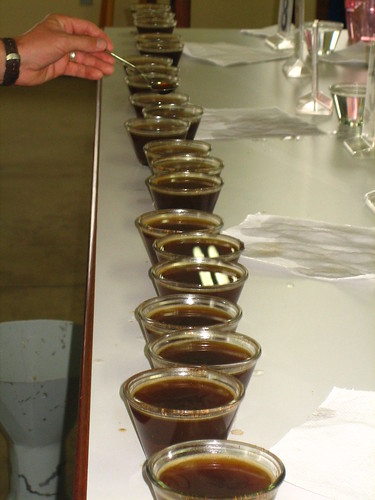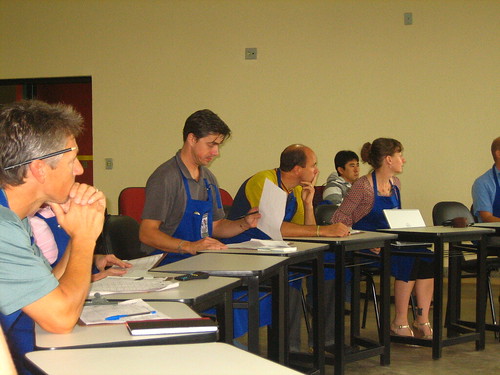More Calibrations, Rio, and those nifty cups...
For those of you who've never been on a cupping panel I should probably dig a little deeper on calibrations. First, the calibration can also serve as a warm-up for the judges, giving them a chance make sure their own senses are dialed-in. As we well know, we all have different palates and different senses of smell. While experienced cuppers tend to be totally tuned into their noses & tongues, they're still individuals with varying life experiences and sense memories. One combination of volatilized compounds in a cup of joe might make me think of my grandma Ellen's canned peaches at the same time that they remind Darrin Daniel of fine a fine Peach Lambic (which he's now obligated to buy for all the judges after the competition.) A strong phenolic taint might make one person think of the time he lit a pencil eraser in grade school (ahem...) or it could call up the sense memory of a burnt out clutch. A key task of a calibration is to ensure that the judges are noticing similar things in the samples-like in #8 today which featured fecund phenols.
Last, but not least, a calibration session can include a discussion of aromas, flavors, and taints particular to the origin. With naturally processed coffees, human influence on the quality of the coffee only goes so far. With the other half of our competition, the processed coffees, a farmer can do much more in post-harvest processing to ensure quality. One particular taint that can plauge Brazilian coffees is the infamous Rio-taint. A lot of work has been done over the years on this fungal contaminant (present in old #8 above) and we're extrememly lucky to have one of Brazil's foremost authorities on this phenomenon on our panel. Professor Flavio Meira Borem of the Federal University of Lavras related some of the recent studies on Rio-taint and how cherry hang-time on the tree is one of the largest factors involved.
Professor Borem has also been actively involved in the Responsible Sourcing Partnership through leading technical trainings for Fair Trade producers. He's also edited a wonderful new book on the technical aspects of post-harvest coffee care. Covering everything from the physics of drying to how to properly warehouse your beans, the book is a tremendous aid to Brazil's small farmers and co-ops. For those attending SCAA next year in Atlanta, you'll be able to purchase the English translation of Professor Borem's book on (and currently available for coffee nerds who read Portuguese.)
A few more pictures of the day's action:

Those nifty cups. They come with little plastic lids to keep the grinds fresh. They might be uniquely Brazilian. Some judges like them and feel the aromas from the ground coffee are more concentrated. Others noted that the lids are rather hard to pull off and aromas might be too concentrated.

John Cossette of Royal, Darrin Daniel of Allegro, Joao Batista Jardli of SAAG Brazil, Takahisa Toda of MC Coffee Brazil, and Wendy de Jong of Tony's.

There's also an awful lot of hot water in Brazil. If you're not a Frank Sinatra fan...

Roasting sample batches on the Probatinho
Last, but not least, a calibration session can include a discussion of aromas, flavors, and taints particular to the origin. With naturally processed coffees, human influence on the quality of the coffee only goes so far. With the other half of our competition, the processed coffees, a farmer can do much more in post-harvest processing to ensure quality. One particular taint that can plauge Brazilian coffees is the infamous Rio-taint. A lot of work has been done over the years on this fungal contaminant (present in old #8 above) and we're extrememly lucky to have one of Brazil's foremost authorities on this phenomenon on our panel. Professor Flavio Meira Borem of the Federal University of Lavras related some of the recent studies on Rio-taint and how cherry hang-time on the tree is one of the largest factors involved.
Professor Borem has also been actively involved in the Responsible Sourcing Partnership through leading technical trainings for Fair Trade producers. He's also edited a wonderful new book on the technical aspects of post-harvest coffee care. Covering everything from the physics of drying to how to properly warehouse your beans, the book is a tremendous aid to Brazil's small farmers and co-ops. For those attending SCAA next year in Atlanta, you'll be able to purchase the English translation of Professor Borem's book on (and currently available for coffee nerds who read Portuguese.)
A few more pictures of the day's action:

Those nifty cups. They come with little plastic lids to keep the grinds fresh. They might be uniquely Brazilian. Some judges like them and feel the aromas from the ground coffee are more concentrated. Others noted that the lids are rather hard to pull off and aromas might be too concentrated.

John Cossette of Royal, Darrin Daniel of Allegro, Joao Batista Jardli of SAAG Brazil, Takahisa Toda of MC Coffee Brazil, and Wendy de Jong of Tony's.

There's also an awful lot of hot water in Brazil. If you're not a Frank Sinatra fan...

Roasting sample batches on the Probatinho
Barista Exchange Partners
Keep Barista Exchange Free
Are you enjoying Barista Exchange? Is it helping you promote your business and helping you network in this great industry? Donate today to keep it free to all members. Supporters can join the "Supporters Group" with a donation. Thanks!
© 2025 Created by Matt Milletto.
Powered by
![]()

You need to be a member of Barista Exchange to add comments!
Join Barista Exchange